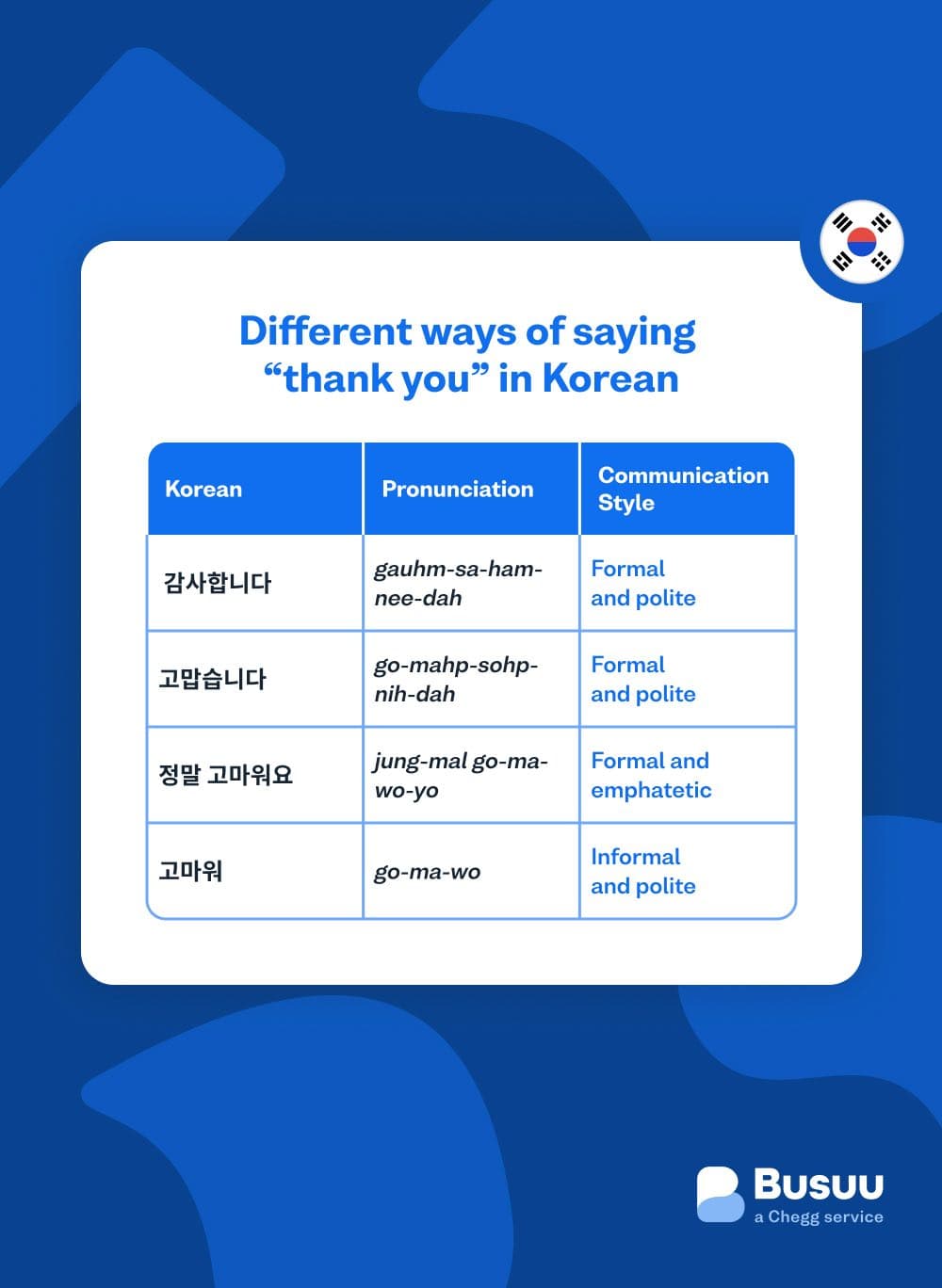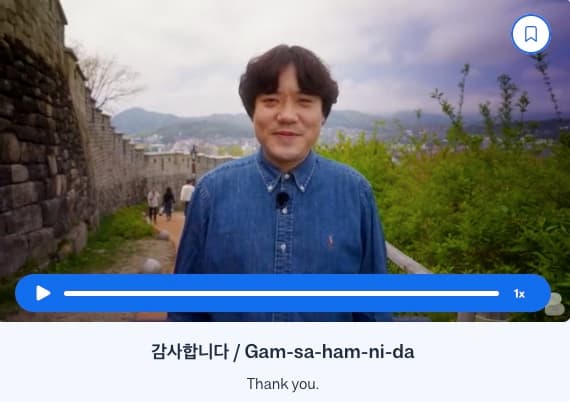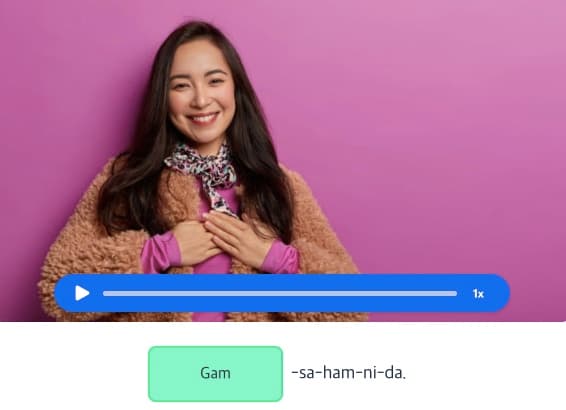I want to learn...
Picture this: you’re sitting at a fun Korean barbeque joint in Seoul and the server brings over your food. Like any polite person, your first reaction is probably to thank them. You freeze and ask yourself:“How do I say thank you in Korean?”
After a moment of panic, you quickly say“Thanks!”with a smile, while silently kicking yourself for not knowing the basic way to say thank you in Korean.
Don’t worry! By the end of this article, you’ll have learned several different ways to say thank you in Korean. You will feel confident using the phrases correctly. We’ll also break them down for you inHangeul, the Korean alphabet. This will allow you to write thank you in Korean as well.
Ready?
시작하자! (shi-jak-ha-ja)
Or, in English,
Let’s begin!
Formality when saying “thank you” in Korean
If you weren’t already aware, the Korean language (one of the oldest languages in the world!) uses honorifics — in many cases, suffixes (word endings) — that denote how formal and polite a word or phrase is.
There are formal 존댓말 (jon-daen-mal) and informal 반말 (ban-mal) ways of speaking.
When it comes to saying thank you, this is particularly important. How you choose to say thank you to a friend or younger sibling will be different from how you say thank you to your boss or to your teacher.
If you don’t know someone and are not sure how old they are, it’s best to be formal and respectful rather than run the risk of offending them. You can never go wrong with being polite!
Once you grasp the basics of honorifics in Korean, you’ll start to notice patterns in how they are used. You’ll even notice some patterns in this lesson.
What is thank you in Korean?
Arranged from formal to more casual, here are four common ways to say thank you in Korean:
감사합니다 (gam-sa-ham-ni-da)
고맙습니다 (go-map-seum-ni-da)
정말 고마워요 (jung-mal go-ma-wo-yo)
고마워 (go-ma-wo)

Ok! Not so bad, right? Now let’s look at when to use these different ways and with whom.
1. 감사합니다 (gam-sa-ham-ni-da) — Formal and polite
This is the most commonly used phrase for saying thank you. You can’t go wrong using it with just about anyone.
If you want to start with learning just one way to say thank you, choose this one! It is both formal and polite. When using it, you don’t have to worry about offending anyone by expressing your gratitude using 감사합니다 (pronunciation:gauhm-sa-ham-nee-dah).
2. 고맙습니다 (go-map-seup-ni-da) — Formal and polite
This way is also commonly used to say thank you in Korean. It can be used with a variety of people without causing offense.
However, it is not quite as formal as 감사합니다 (pronunciation:go-mahp-sohp-nih-dah). For this reason, it is more often used with people you are familiar with.
고맙습니다 is appropriate with your mother-in-law, for example. It shouldn’t be used in a business meeting with your company’s CEO.
3. 정말 고마워요 (jung-mal go-ma-wo-yo) — Formal and emphatic
This method of saying thank you in Korean translates to“thank you sincerely”or“really, thank you”. The approach is more emphatic.
Use it when someone has done something particularly helpful and you want to let them know just how nice it was. By using 정말 고마워요(pronunciation: jung-mal go-ma-wo-yo) you are still being formal and polite.
4. 고마워 (go-ma-wo) — Informal and polite
Your Korean friends or classmates may give you a funny look if you use 감사합니다 (pronunciation: gahm-sahab-needa) with them (so formal!).
Instead, try 고마워 (pronunciation: go-ma-wo). It is an alternative that is less formal. Use it with people who are the same age as you and with whom you are familiar with.
If this person is a younger colleague, you can say 고마워요 (go-mah-wo-yo / pronunciation: go-ma-wo-yo). Notice the addition of the polite ending 요 (yo) used to make sure you are being extra polite in the work setting.
Just a reminder: Even if you are really familiar with a work colleague, if they are older than you and/or have a higher position than you, you should still use 감사합니다 (pronunciation: gahm-sahab-needa) unless they tell you otherwise.
Remember, if you are in doubt is 고마워 (pronunciation: goh-mah-woh) or 고마워요 (pronunciation: goh-mah-woh-yuoh) are acceptable, use 감사합니다 (pronunciation: gahm-sahab-needa) just to be safe.
Back to the basics
Now that we’ve gone through ways to say thank you in Korean, let’s take a closer look at the words themselves.
감사하다 (gam-sa-ha-da) is a combination of 감사 (gratitude or giving thanks) and 하다 (to do). We see these used in the common phrase 감사합니다 (pronunciation: gam-sa-ham-ni-da).
고맙다 (go-map-da) means to be grateful, and it is used in phrases like:
고맙습니다 (gomabseubnida / pronunciation: go-map-seum-ni-da)
고마워 (요) (gomawo (yo) / pronunciation: go-ma-wo-(yo))
정말 고마워요 (jeongmal gomawoyo / pronunciation: jung-mal go-ma-wo-(yo))
As mentioned, 요 (yo / pronunciation: yoh) is a suffix used to make a word or phrase more formal and polite. It is commonly used in phrases such as:
고마워 (요) (gomawo (yo) / pronunciation: go-ma-wo-(yo))
정말 고마워요 (jeongmal gomawoyo / pronunciation: jung-mal go-ma-wo-(yo))
Learning the roots and meanings of common words will help you understand how they can be used. It will empower you on your Korean language journey!
Use body language to say thank you in Korean
It is always important to make sure you are being polite and respectful. Ways to say thank you in Korean show respect and etiquette when it comes to how you speak.
Koreans also demonstrate their respect and gratitude using body language. They bow when they say thanks. This is actually very similar to Japanese, where bowing is also used to show thanks. The deepness of the bow demonstrates your level of respect. To learn more, you can read our guide on how to say thank you in Japanese.
When you say thank you to those who are older than you, you should bow your head a little and say 감사합니다 (gam-sa-ham-ni-da). This is a polite and respectful way of proceeding.
In more formal settings, and with people who are higher up in the hierarchy, your bow should be deeper, about a 45-degree angle.
However, with close friends, you don't need to do that.
The more formal the setting, the more respectful you should be, and your bow should match accordingly.
Bonus phrases for saying thank you in Korean
Feeling pretty confident with our first four phrases? Here are some more ways to show your appreciation and express gratitude in Korean:
대단히 감사합니다 (dae-dan-hi gam-sa-ham-ni-da)
정말 친절하시네요 (jung-mal chin-jul-ha-si-ne-yo)
감사 (gam-sa)
Let’s look into each of these phrases and see where, when, and in which situations they can best be used:
1. 대단히 감사합니다 (dae-dan-hi gahm-sa-hab-ni-da)
This phrase is another formal way to say,“thank you very much”. Use it for situations where someone has truly gone out of their way for you. Don’t forget to the cultural bow.
2. 정말 친절하시네요 (jung-mal chin-jul-ha-si-ne-yo)
This formal variation can be used to express that you are truly grateful. You can use it to tell someone:“wow, you’re so kind”.
3. 감사 (gam-sa)
This word is short, fun and casual. Use it to say“thanks”to friends.
Just remember, this should never be used with someone older than you or in a formal setting. Close friends and younger family members only, okay?
Take things to the next level
By now, we’re sure you’re feeling pretty confident when it comes to saying thanks in Korean. Your next step is to get out there and practice!
Remember, when in doubt, err on the side of formality. You can never go wrong with being too polite.
AUTHOR

Keehwan Kim
Newlanguages


